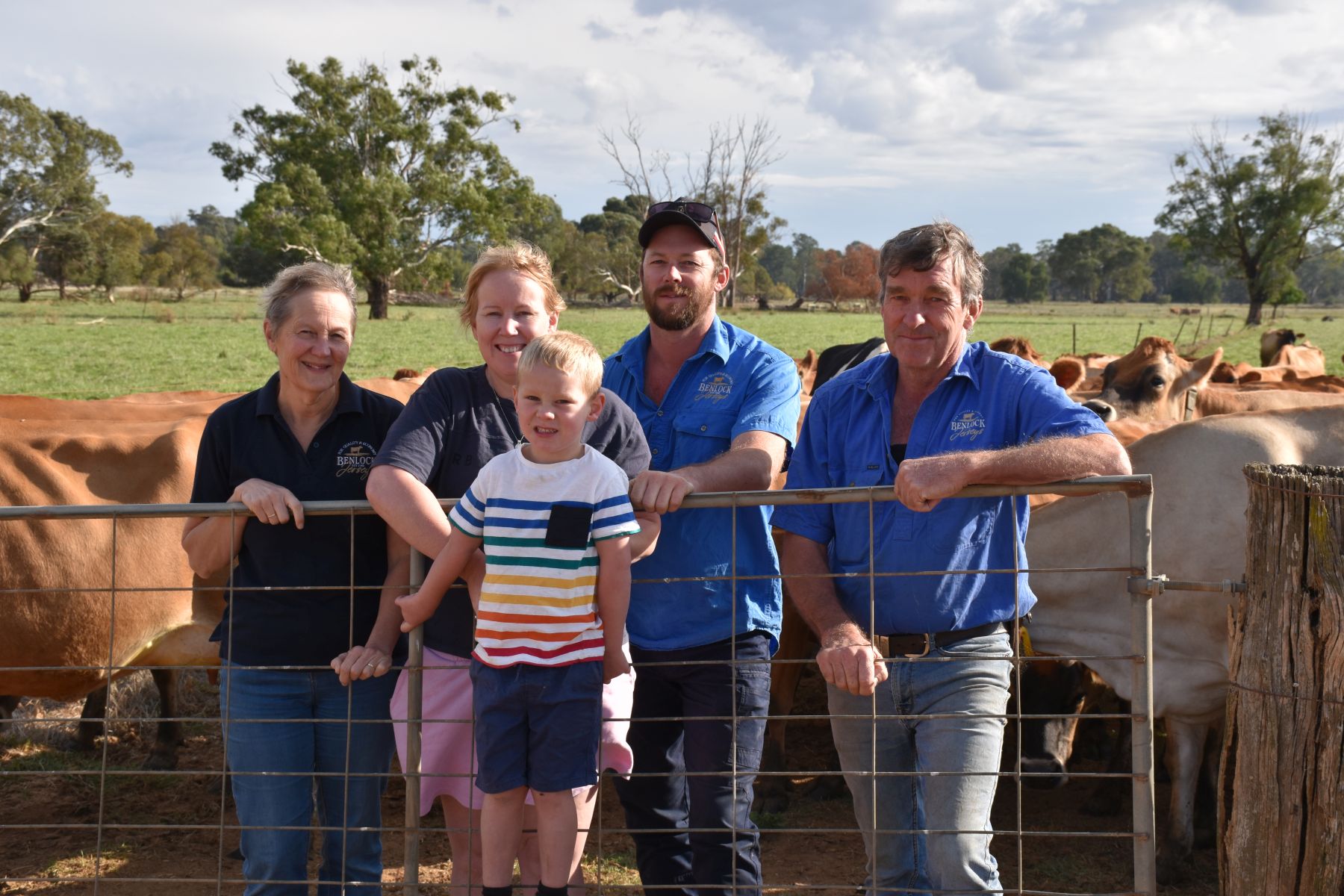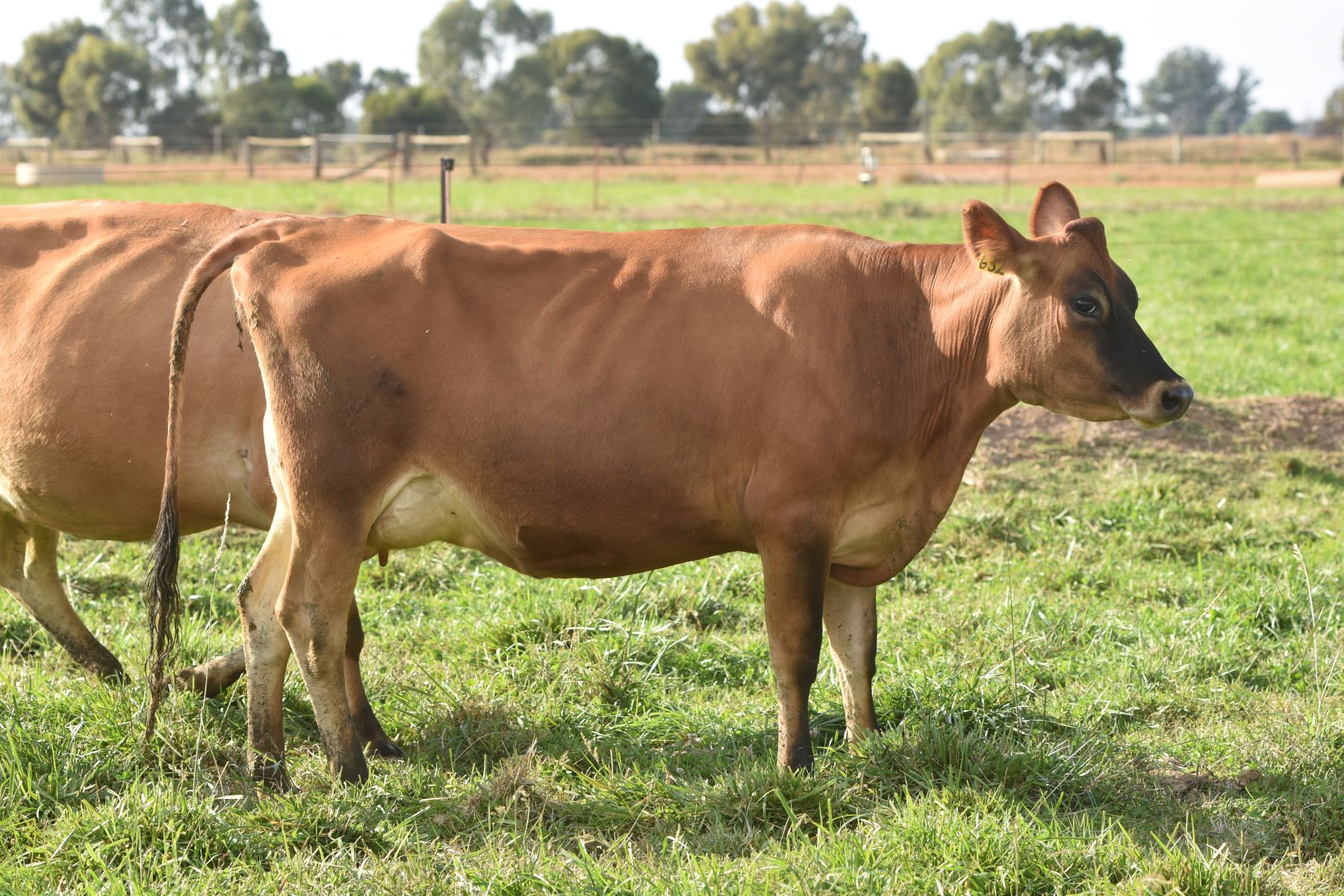Young stock data focus helps boost BPI
Rushton family
Region: Northern Victoria
Topic: BPI
A trip to the United States showed one Northern Victorian dairy farmer how quickly the genetic merit of a herd can improve.
Back home at Rochester, tools such as genomic testing, sexed semen, and DataGene’s Balanced Performance Index (BPI) are making it a reality in his family’s 280 Jersey herd.
Andrew Rushton, wife Jess, children Brodie 4 and Grace 2 own and operate Benlock Jerseys with his parents, Bryan and Lee.

The Rushton family: Lee, Jess, Andrew and Bryan with Brodie (at front).
DataGene’s review of herd performance in March 2024 showed Benlock had increased its herd average BPI by 310% to 172 BPI, since 2020.
The BPI accounts for the traits that affect a cow’s lifetime contribution to the farm business: production, health/fertility, longevity, workability, feed efficiency and type.
“It’s good to see what we are doing is working,” Andrew said.
“These types of advancements – genomics and sexed semen – we have to take hold of and use the data the best we can so we can reap the rewards in the future.”
The Rushtons genomic test their heifer calves, at 7-10 days old, to identify the genetic potential of each female as early as possible.
“I look at that data 12 months in, before they are joined, to see where the top half are according to BPI,” Andrew said.
“We won’t necessarily cull on data, but we breed the top portion to sexed semen and use conventional semen on the rest. It’s one of the ways we ensure we are rearing the best heifer calves. It also saves us money on sexed semen because we aren’t blanket-joining the whole group.
“Our best genetic gain is out of those top heifers and the quicker we can get a calf out of that heifer, the bigger our genetic jump.”
Retaining heifer calves from Benlocks’ best young females represents a significant practice change for the farm business.
Previously, the Rushtons would run their own herd bull with their heifers and sell all the resulting calves. The heifers – for replacements – would be retained from the offspring of the milking herd.
This isn’t the only change behind the improvement in the Rushtons’ herd average BPI.
The family has been using a team of five bulls, selected with the assistance of a breeding consultant, to improve specific traits.
“We work closely with Ben Pedretti. He scores the heifers and picks out three traits that we want to improve and from there we work together to select the bulls,” Andrew said.
“We pick a bull team of five, we don’t use too many because it gets confusing, and between Ben, myself and dad we go through and pick. We are always looking at teat placement and type, more recently daughter fertility and always on the Australian system – the BPI.
“The BPI takes into account so many other things that aren’t visual, such as survival, daughter fertility and all the things you can’t see.”
Andrew uses DataGene’s Good Bulls app as a quick and easy way to check the pedigree of an unknown bull.
He said the app is a better option that looking through “hundreds of catalogues” that clutter the office.
Bulls that carry DataGene’s Good Bulls logo meet the minimum criteria for Balanced Performance Index and reliability and are available for purchase.

Benlock Eileen 160 is the top heifer in the herd at BPI 417.
Twelve months ago, Andrew, Jess and their children moved out to the family farm to officially take over the management from his parents Bryan and Lee.
Tongue-in-cheek, Andrew said the improvement in Benlocks’ herd average BPI was proof that he hadn’t “totally stuffed the job” after taking over the breeding side of the operation from his parents.
More seriously though, he said the BPI improvement came from a “good base” of Jersey cows and a focus on continual improvement.
Last year Andrew also travelled to the US with regional development organisation Murray Dairy as part of a study tour. He visited ST Genetics bull facility at Wisconsin where he confirmed his practice of focusing on young stock was the best way to lift genetic gain.
“One thing they did there to progress quickly, they were using eggs from calves and semen from calves to get genetic gain,” Andrew explained.
“It was quicker than waiting for the heifer to grow out and really opened my eyes to how quickly a herd can improve.”
For more information www.datavat.com.au or email abv@datagene.com.au


